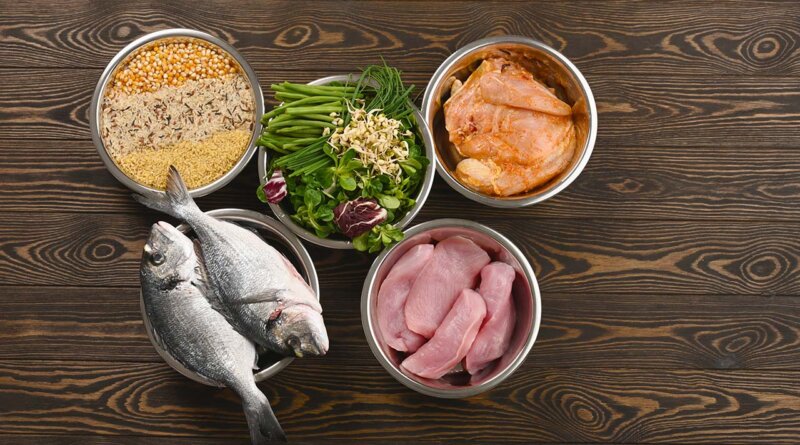5 Reasons to Start Making Dog Food at Home – Top Dog Tips
If you’re reading this article, you’ve likely been toying with the idea of making your own DIY dog food. Making home cooked dog food allow you to cater to your pet’s needs. Whether he’s on a special diet or you’re just concerned about the quality of commercial pet food, there are many good reasons to start making dog food at home.
Before You Start…
I’m sure you’ve heard the horror stories about chemicals and dangerous ingredients that are potentially carcinogenic and have been found in some commercial dog food brands. Unfortunately, pet food regulations in the United States are very lax, and some companies take advantage of that.
Making DIY dog food can be a healthier alternative, but only when it’s done properly. The first thing you need to know about switching to a homemade diet is that it will NOT be easy. There’s a lot research to be done, and it’s best to work with an expert trained in canine nutrition who can guide you in creating properly balanced recipes.
Sadly, a famous study from the University of California, Davis, School of Veterinary Medicine proves that recipes created for canines are not usually nutritionally balanced. They selected 200 recipes from 34 different sources, including dog care books, veterinary textbooks and dependable online resources.
Of the 200 recipes that they looked at, only nine dog food recipes provided balanced nutrition in concentrations meeting the minimum standards established for adult canines by the AAFCO. Of those nine recipes, only five provided adult dogs with essential nutrients in concentrations that met the NRC’s Minimum Requirements.
All of the beneficial reasons to start making homemade dog food meals at home will be outweighed if you’re not providing your dog with the balanced nutrition that his body needs. Thus, it’s crucial that you work with a canine nutritionist or a knowledgeable vet to ensure that your homemade meals are going to provide the right nutrition for your dog.
5 Reasons to Start Making Dog Food at Home
 1. Best Nutrition for Each Individual Dog
1. Best Nutrition for Each Individual Dog
Like humans, dogs are all different. Each dog has their own unique nutritional needs based on factors such as:
- age
- weight
- activity level
- breed
- health condition
Every dog has unique needs when it comes to how much protein, carbohydrates, fat, vitamins and minerals their body will need in a day. It’s also important to remember that your dog’s nutritional needs will change over time. For example, a puppy will have different nutritional needs than an adult dog. If your dog is diagnosed with a health condition, like arthritis or a heart condition, his nutritional needs will change.
Do you think a commercial dog food product that is created for “dogs of all life stages” or “adult dogs” will meet all of your pups needs? Of course not! These dog food products use a “blanket” approach to nutrition that will meet the needs of the “average” dog. Is your dog average?
One of the best reasons to start making dog food at home is that you can cater the recipes to meet your dog’s exact needs. A good homemade dog food must contain the right proportion of ingredients that your canine requires based on the dog’s age, size, breed, activity and health.
Skipping one component or going overboard with another can have a negative effect on your dog’s health, especially if it’s done consistently. If you want to create the best recipes, you need to work with an expert in canine nutrition.
2. Quality Ingredients = Quality Food
Dog food companies have to list the ingredients they use, but do you have any idea what the quality of the ingredients are? Where they’re sourced? How they’ve been processed? When you make dog food at home, you are in charge of the ingredients.
I recommend buying the best quality ingredients that you can afford, meat and vegetables. If possible, get all-natural and organic ingredients. The better quality of the ingredients, the better nutrition they will provide.
3. No Fillers or Artificial Preservatives
Most commercial dog foods use additives and preservatives to prevent it from spoiling over its shelf life, whereas homemade foods do not require the use of preservatives. A common preservative used in dog food is a chemical called ethoxyquin. It is a pesticide and could be toxic to dogs over time.
Other negative side effects of consuming foods that contain ethoxyquin include:
- liver cell death
- a decrease in physical activity
- discolored urine
- pale gums, which indicates bad circulation
BHA (butylated hydroxyanisole) and BHT (butylated hydroxytoluene) are also common preservatives in pet food. Both are currently labeled by the World Health Organization as carcinogens.
Many commercial pet foods also contain high amounts of grains like soy, corn, wheat, rice and other fillers. Studies have shown that dogs have issues digesting certain grains.
Glutenous ingredients can also be harmful to dogs in other ways. They can cause inflammation and allergic reactions. This is not the case with all grains and for all dogs, but it’s still worth considering for both commercial dog food brands and homemade meals.
4. Variety
Would you like to eat the same meal everyday for months at a time? Of course not! So, what makes you think your dog wants to? One of the best reasons to start making dog food at home is because you can provide unlimited options of variety to tempt your pup’s palate.
Providing your dog a variety of homemade foods can also improve his nutrition and prevent allergies. In fact, intestinal upset when switching foods is a sign that your dog needs more variety. By making homemade dog food, you can ensure that he gets variety in the meals so he can get the best balance in nutrients and vitamins.
5. Cater To Your Dog’s Needs
As I mentioned earlier, homemade dog food recipes can be catered to your dog’s specific needs. Whether he has allergies, a health condition or digestive sensitivities, you can make meals that will be safe and healthy. However, it’s important to work with a canine nutrition expert to ensure that the meals you are serving will be the best choice for your canine companion.
There are other reasons to start making dog food at home, but these are my top 5. For more information about making your own dog food, check out the other resources on our website and consult with your veterinarian.
READ NEXT: 50 Best Homemade Dog Food Recipes





Hiya, I’m really glad I’ve found this info. Today bloggers publish just about gossip and web stuff and this is actually frustrating. A good web site with interesting content, that is what I need. Thank you for making this site, and I’ll be visiting again. Do you do newsletters by email?